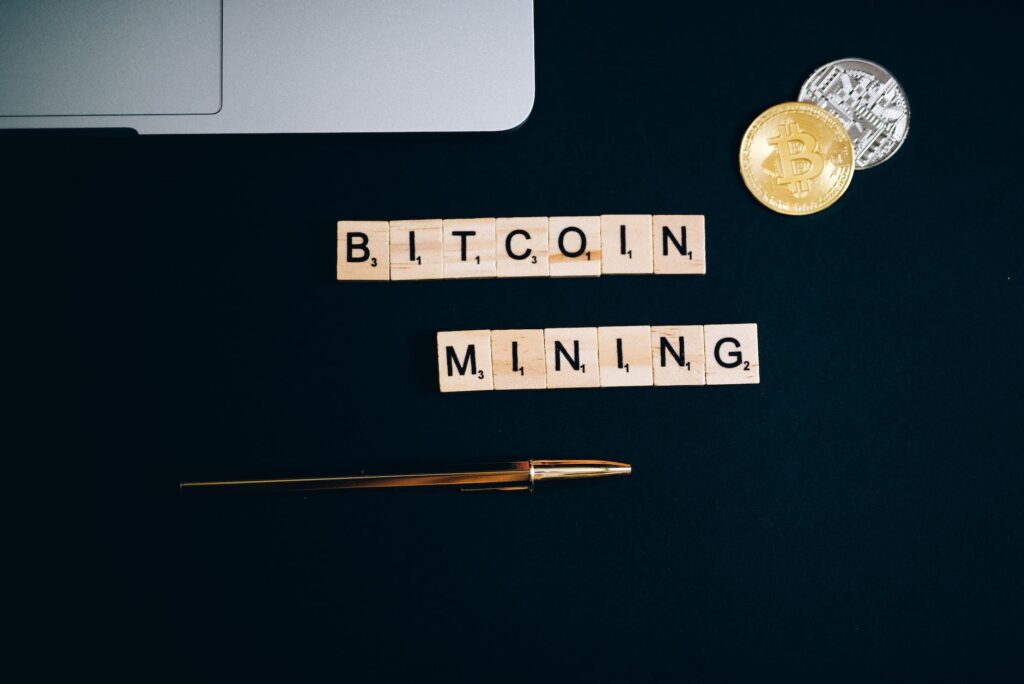Die Grundlagen des Bitcoin-Minings
Zum Verständnis der Auswirkungen von Bitcoin Schwierigkeit des Bergbaus für die Bergleute, ist es wichtig, die Grundlagen der Bitcoin-Schürfen und die Rolle, die Miner im Bitcoin-Netzwerk spielen.
Was ist Bitcoin-Mining?
Bitcoin-Mining ist der Prozess, durch den neue Bitcoins erzeugt und Transaktionen im Bitcoin-Netzwerk überprüft werden. Es beinhaltet das Lösen komplexer mathematischer Probleme unter Verwendung spezieller Hardware und Software. Miner konkurrieren miteinander, um diese mathematischen Rätsel zu lösen, und der erste Miner, der eine Lösung findet, wird mit einer bestimmten Menge an neu geprägten Bitcoins belohnt.
Der Prozess des Minings dient in erster Linie zwei Zwecken. Erstens gewährleistet es die Sicherheit und Integrität des Bitcoin-Netzwerks, indem es Transaktionen validiert und verifiziert. Zweitens werden durch das Mining neue Bitcoins in Umlauf gebracht, wodurch ein begrenztes und kontrolliertes Angebot der Kryptowährung aufrechterhalten wird.
Die Rolle der Miner im Bitcoin-Netzwerk
Miner spielen eine wichtige Rolle im Bitcoin-Netzwerk. Ihre Hauptaufgabe ist es, die Rechtmäßigkeit von Transaktionen zu überprüfen und zu bestätigen. Wenn eine Bitcoin-Transaktion durchgeführt wird, wird sie an das Netzwerk weitergeleitet und in einen Pool von unbestätigten Transaktionen aufgenommen, der als Mempool bekannt ist.
Die Miner wählen dann eine Reihe von Transaktionen aus dem Mempool aus und bündeln sie zu einem Block. Sie setzen ihre Rechenleistung ein, um das mit dem Block verbundene mathematische Problem zu lösen. Sobald ein Miner das Problem erfolgreich gelöst hat, fügt er den Block zur Blockchain hinzu, dem öffentlichen Buch, das alle Bitcoin-Transaktionen aufzeichnet.
Neben der Validierung von Transaktionen und dem Hinzufügen von Blöcken zur Blockchain sichern die Miner das Netzwerk auch, indem sie ihre Rechenleistung zur Verfügung stellen. Die dezentrale Natur von Bitcoin beruht darauf, dass die Miner gemeinsam die Sicherheit des Netzwerks aufrechterhalten und betrügerische Aktivitäten verhindern.
Da der Schwierigkeitsgrad des Minings mit der Zeit zunimmt, sehen sich Miner mit verschiedenen Herausforderungen und Überlegungen konfrontiert, die sich auf ihre Rentabilität und ihren Betrieb auswirken. Das Verständnis der Feinheiten der Mining-Schwierigkeit ist entscheidend für Miner, um sich anzupassen und in der sich ständig entwickelnden Landschaft des Bitcoin-Minings zu gedeihen.
Verständnis der Bitcoin-Mining-Schwierigkeit
Um die Auswirkungen der Bitcoin-Mining-Schwierigkeit auf die Miner vollständig zu verstehen, ist es entscheidend, ein klares Verständnis davon zu haben, was die Mining-Schwierigkeit ist und wie sie berechnet wird. Außerdem ist es wichtig, die Faktoren zu erforschen, die die Anpassungen der Mining-Schwierigkeit beeinflussen.
Definition und Berechnung des Schwierigkeitsgrads im Bergbau
Die Bitcoin-Mining-Schwierigkeit ist das Maß dafür, wie schwierig es ist, einen neuen Block in der Bitcoin-Blockchain zu finden. Sie soll sicherstellen, dass der Blockchain in gleichmäßigem Rhythmus, etwa alle 10 Minuten, neue Blöcke hinzugefügt werden. Die Mining-Schwierigkeit wird vom Bitcoin-Netzwerk automatisch alle 2016 Blöcke, also etwa alle zwei Wochen, angepasst.
Die Berechnung der Mining-Schwierigkeit basiert auf einem Zielwert, einer willkürlichen Zahl, die vom Bitcoin-Protokoll festgelegt wird. Miner müssen einen Hashwert finden, der unter diesem Zielwert liegt, um einen Block erfolgreich zu minen. Ist der Hash-Wert höher als der Zielwert, muss der Miner weiter nach einem gültigen Hash-Wert suchen. Je niedriger der Zielwert ist, desto schwieriger ist es, einen gültigen Hashwert zu finden.
Die Bitcoin-Mining-Schwierigkeit wird anhand einer Formel berechnet, die die Zeit berücksichtigt, die für das Mining der letzten 2016er Blöcke benötigt wurde. Wenn es weniger als zwei Wochen gedauert hat, erhöht sich die Schwierigkeit, was es schwieriger macht, einen gültigen Hash zu finden. Umgekehrt sinkt die Schwierigkeit, wenn es länger als zwei Wochen gedauert hat, wodurch es einfacher wird, einen gültigen Hash zu finden. Dieser Anpassungsmechanismus sorgt dafür, dass die Blockzeit im Laufe der Zeit relativ stabil bleibt.
Faktoren, die die Anpassung des Schwierigkeitsgrads im Bergbau beeinflussen
Mehrere Faktoren beeinflussen die Anpassungen der Bitcoin-Mining-Schwierigkeit. Zu diesen Faktoren gehören:
-
Hashing Leistung: Die gesamte Rechenleistung, die für das Mining von Bitcoin eingesetzt wird, spielt eine wichtige Rolle bei der Bestimmung der Mining-Schwierigkeit. Je mehr Miner dem Netzwerk beitreten oder ihre Mining-Ausrüstung aufrüsten, desto höher ist die gesamte Hashing-Leistung. Dies wiederum führt zu einer höheren Mining-Schwierigkeit, um die gewünschte Blockzeit zu erreichen.
-
Blockzeit: Die Zeit, die für den Abbau eines Blocks benötigt wird, wirkt sich direkt auf die Schwierigkeit des Abbaus aus. Werden die Blöcke schneller abgebaut als die angestrebte Blockzeit von 10 Minuten, erhöht sich der Schwierigkeitsgrad. Umgekehrt nimmt die Schwierigkeit ab, wenn die Blöcke zu langsam abgebaut werden.
-
Effizienz im Bergbau: Fortschritte in der Mining-Hardwaretechnologie können die Effizienz des Minings erheblich beeinflussen. Leistungsfähigere und energieeffizientere Mining-Geräte können die Hashing-Leistung erhöhen und gleichzeitig den Energieverbrauch senken. Schürfer, die eine effizientere Ausrüstung verwenden, können zu einer Erhöhung der gesamten Hashing-Leistung des Netzwerks beitragen, was zu einem Anstieg der Schwierigkeit beim Schürfen führt.
Durch das Verständnis der Definition und Berechnung der Mining-Schwierigkeit sowie der Faktoren, die ihre Anpassung beeinflussen, können Miner die mit dem Bitcoin-Mining verbundenen Herausforderungen und Chancen besser verstehen. Um Strategien für den Umgang mit der Mining-Schwierigkeit zu erforschen und in der Mining-Industrie wettbewerbsfähig zu bleiben, lesen Sie den nächsten Abschnitt weiter.
Auswirkungen der Schwierigkeit des Bergbaus auf die Bergleute
Da der Schwierigkeitsgrad des Bitcoin-Minings zunimmt, stehen Miner vor verschiedenen Herausforderungen, die sich auf ihre Rentabilität und ihren Betrieb auswirken. In diesem Abschnitt werden wir die Auswirkungen der Mining-Schwierigkeit auf die Miner untersuchen, einschließlich des verstärkten Wettbewerbs und der geringeren Belohnungen, der Mining-Ausrüstung und der Energiekosten sowie der Rolle von Mining-Pools und kollektiven Bemühungen.
Verstärkter Wettbewerb und geringere Belohnungen
Wenn die Schwierigkeit des Minings steigt, treten mehr Miner in das Netzwerk ein, was zu einem verstärkten Wettbewerb um die Blockbelohnungen führt. Da alle 10 Minuten nur eine begrenzte Anzahl von Bitcoins generiert wird, müssen die Miner in leistungsstarke Hardware und effiziente Mining-Verfahren investieren, um wettbewerbsfähig zu bleiben.
Der verstärkte Wettbewerb führt auch zu einer Verringerung der Belohnungen für die einzelnen Miner. Miner erhalten nun kleinere Bruchteile von Bitcoins pro Block, was es schwieriger macht, ihre Ausgaben zu decken und signifikante Gewinne zu erzielen. Gewinne. Für Miner ist es entscheidend, ihre Mining-Strategien sorgfältig zu überdenken, einschließlich Faktoren wie Stromkosten, Hardware-Effizienz und die Beteiligung an Mining-Pools.
Bergbauausrüstung und Energiekosten
Der steigende Schwierigkeitsgrad beim Mining erfordert den Einsatz von fortschrittlicher und spezialisierter Mining-Ausrüstung. Miner müssen in leistungsstarke Hardware investieren, wie z. B. Bitcoin-Bergbau-Hardware, um komplexe mathematische Probleme zu lösen und Blockprämien zu sichern. Diese Maschinen haben oft einen hohen Preis, und um wettbewerbsfähig zu bleiben, ist es wichtig, mit der neuesten Technologie Schritt zu halten.
Auch das Mining erfordert eine erhebliche Menge an Energie. Je höher der Schwierigkeitsgrad, desto mehr Rechenleistung benötigen die Miner, was sich in einem höheren Stromverbrauch niederschlägt. Die steigenden Energiekosten können die potenziellen Gewinne der Miner aufzehren, weshalb ein effizientes Energiemanagement und der Zugang zu erschwinglichem Strom von entscheidender Bedeutung sind.
Bergbau-Pools und kollektive Anstrengungen
Die Schwierigkeit des Mining hat zum Aufkommen von Mining-Pools geführt, in denen einzelne Miner ihre Ressourcen zusammenlegen und gemeinsam an der Lösung komplexer mathematischer Probleme arbeiten. Indem sie ihre Kräfte bündeln, erhöhen sie ihre Chancen, einen Block erfolgreich zu schürfen und einen Anteil an der Belohnung zu erhalten. Bitcoin-Schürfstellen den Bergleuten eine Möglichkeit bieten, die Auswirkungen der zunehmenden Schwierigkeit abzumildern und ein beständigeres Einkommen zu erzielen.
Das Pooling von Ressourcen ermöglicht es den Schürfern auch, die Kosten für Ausrüstung und Strom zu teilen, wodurch die Teilnahme am Schürfprozess erschwinglicher wird. Allerdings sollten Miner ihren Mining-Pool sorgfältig auswählen und dabei Faktoren wie Pool-Gebühren, Ruf, Größe und Verteilung des Pools berücksichtigen.
Durch die Zusammenarbeit in Mining-Pools und die Nutzung kollektiver Anstrengungen können die Miner die Herausforderungen des steigenden Schwierigkeitsgrads meistern und ihre Erfolgschancen erhöhen.
Das Verständnis der Auswirkungen der Mining-Schwierigkeit auf die Miner ist für diejenigen, die am Bitcoin-Mining interessiert sind, von entscheidender Bedeutung. Es ist wichtig, Faktoren wie verstärkte Konkurrenz und geringere Belohnungen, Mining-Ausrüstung und Energiekosten sowie die Vorteile der Teilnahme an Mining-Pools zu berücksichtigen. Indem sie auf dem Laufenden bleiben und ihre Strategien an die sich verändernde Landschaft anpassen, können Miner ihren Betrieb optimieren und ihre Chancen auf Profitabilität im Bitcoin-Mining-Ökosystem maximieren.
Strategien zur Bewältigung von Bergbau-Schwierigkeiten
Die Schwierigkeit des Bitcoin-Minings kann für Miner eine Herausforderung darstellen, da sie mit der Zeit zunimmt. Es gibt jedoch mehrere Strategien, die Miner anwenden können, um diese Schwierigkeiten zu überwinden und weiterhin am Mining-Prozess teilzunehmen. Lassen Sie uns drei effektive Strategien untersuchen: Aufrüstung der Mining-Ausrüstung, Beitritt zu Mining-Pools und Erkundung alternativer Kryptowährungen.
Aufrüstung von Bergbauausrüstung
Da der Schwierigkeitsgrad des Minings zunimmt, ist es für die Miner unerlässlich, ihre Mining-Ausrüstung aufzurüsten, um wettbewerbsfähig zu bleiben. Neuere und effizientere Hardware kann höhere Hash-Raten liefern, wodurch die Miner komplexe mathematische Probleme schneller lösen können. Dies wiederum erhöht ihre Chancen, erfolgreich neue Blöcke zu schürfen und Belohnungen zu erhalten.
Die Bergleute sollten den Markt regelmäßig nach den neuesten Bitcoin-Mining-Hardware um Modelle zu finden, die eine bessere Leistung und Energieeffizienz bieten. Die Modernisierung der Ausrüstung kann den Bergleuten helfen, ihre Rentabilität zu erhalten und die Herausforderungen zu bewältigen, die sich aus den steigenden Schwierigkeiten im Bergbau ergeben.
Beitritt zu Mining Pools
Eine weitere wirksame Strategie zur Bewältigung der Mining-Schwierigkeiten ist der Beitritt zu einem Mining-Pool. Mining-Pools ermöglichen es einzelnen Minern, ihre Rechenleistung zu bündeln und gemeinsam Blöcke zu schürfen. Durch die Bündelung von Ressourcen können die Schürfer ihre Chancen auf den erfolgreichen Abbau neuer Blöcke und die Erzielung von Belohnungen erhöhen, selbst wenn der Schwierigkeitsgrad des Abbaus hoch ist.
Der Beitritt zu einem Mining-Pool verschafft Bergleuten einen beständigeren und vorhersehbaren Einkommensstrom, da die Belohnungen unter den Teilnehmern auf der Grundlage ihrer Beiträge verteilt werden. Dieser Ansatz kann dazu beitragen, die Auswirkungen von Schwankungen der Mining-Schwierigkeit zu mildern und ein stabileres Einkommen zu erzielen. Um mehr über Mining-Pools zu erfahren, lesen Sie unseren Artikel über Bitcoin-Mining-Pools.
Alternative Kryptowährungen erforschen
In einigen Fällen kann es für Miner vorteilhaft sein, alternative Kryptowährungen zum Mining zu nutzen. Bitcoin ist zwar nach wie vor die bekannteste und am häufigsten geschürfte Kryptowährung, aber es gibt zahlreiche andere Kryptowährungen. Einige dieser Kryptowährungen haben niedrigere Mining-Schwierigkeitsgrade, wodurch sie für Miner zugänglicher und potenziell profitabler sind.
Miner sollten die Mining-Schwierigkeit, den Marktwert und die potenziellen Zukunftsaussichten alternativer Kryptowährungen untersuchen und bewerten. Durch die Diversifizierung ihrer Mining-Aktivitäten können sich Miner an veränderte Marktbedingungen anpassen und potenziell lukrativere Möglichkeiten finden. Es ist jedoch wichtig zu beachten, dass das Mining alternativer Kryptowährungen andere technische Anforderungen und Überlegungen mit sich bringen kann.
Durch die Anwendung dieser Strategien können Miner die Herausforderungen, die sich aus der zunehmenden Schwierigkeit des Minings ergeben, effektiv bewältigen. Das Aufrüsten von Mining-Ausrüstung, der Beitritt zu Mining-Pools und die Erkundung alternativer Kryptowährungen sind allesamt praktikable Optionen für Miner, um ihre Teilnahme am Mining-Prozess aufrechtzuerhalten und weiterhin Belohnungen zu verdienen. Für Miner ist es wichtig, sich über die neuesten Entwicklungen in der Branche zu informieren und ihre Strategien entsprechend anzupassen, um ihre Mining-Bemühungen zu optimieren.
Die Zukunft der Bitcoin-Mining-Schwierigkeit
Da sich die Welt des Bitcoin-Minings ständig weiterentwickelt, ist es wichtig, die zukünftigen Trends und Herausforderungen zu berücksichtigen, mit denen Miner konfrontiert werden könnten. Darüber hinaus kann die Erforschung von Innovationen und Lösungen in der Mining-Technologie Einblicke in die potenziellen Fortschritte und Verbesserungen in der Branche geben.
Voraussichtliche Trends und Herausforderungen
Die Zukunft der Bitcoin-Mining-Schwierigkeit wird wahrscheinlich von mehreren wichtigen Trends und Herausforderungen beeinflusst werden. Ein wichtiger Trend ist der zunehmende Wettbewerb unter den Minern. Da immer mehr Einzelpersonen und Organisationen in den Mining-Bereich einsteigen, wird erwartet, dass die allgemeine Mining-Schwierigkeit steigt. Dies kann dazu führen, dass die Belohnungen für einzelne Miner sinken und es schwieriger wird, Gewinne zu erzielen. Um wettbewerbsfähig zu bleiben, müssen die Miner möglicherweise in leistungsfähigere Bergbauausrüstung und ihren Betrieb zu optimieren.
Eine weitere Herausforderung, der sich die Miner in Zukunft stellen könnten, sind die steigenden Energiekosten im Zusammenhang mit dem Mining. Das Bitcoin-Mining erfordert eine erhebliche Rechenleistung, die eine beträchtliche Menge an Strom verbraucht. Da die Energiekosten schwanken und die Umweltbedenken in Bezug auf den Energieverbrauch zunehmen, müssen die Miner möglicherweise innovative Wege finden, um ihren Energieverbrauch zu senken oder alternative Energiequellen zu erschließen.
Darüber hinaus können regulatorische Änderungen und staatliche Eingriffe die Zukunft des Bitcoin-Minings beeinflussen. Da Regierungen auf der ganzen Welt Vorschriften für Kryptowährungen entwickeln, müssen sich Miner möglicherweise mit rechtlichen Anforderungen, Steuerrichtlinien und Lizenzierungsverfahren auseinandersetzen. Die Anpassung an diese sich entwickelnde regulatorische Landschaft wird für Miner entscheidend sein, um die Einhaltung der Vorschriften zu gewährleisten und potenzielle Risiken zu minimieren.
Innovationen und Lösungen in der Bergbautechnik
Innovationen in der Bergbautechnologie bieten potenzielle Lösungen für die Herausforderungen, mit denen die Bergleute konfrontiert sind. Ein Bereich der Innovation ist die Entwicklung von effizienteren Bergbau-Hardware. Die Hersteller verbessern kontinuierlich die Leistung und Energieeffizienz von Mining-Rigs, so dass Miner höhere Hash-Raten bei geringerem Stromverbrauch erzielen können. Die Aufrüstung auf fortschrittlichere Hardware kann zu einer höheren Rentabilität und einem nachhaltigeren Mining-Betrieb führen.
Darüber hinaus ist das Aufkommen von Schürfstellen ist zu einer beliebten Strategie für Schürfer geworden, um ihre Ressourcen zu bündeln und ihre Chancen auf Belohnungen zu erhöhen. Durch die Bündelung ihrer Hashing-Leistung können die Schürfer gemeinsam häufiger Blöcke lösen, was zu gleichmäßigeren Gewinnen führt. Der Beitritt zu einem Mining-Pool kann insbesondere für Einzelschürfer mit begrenzten Ressourcen von Vorteil sein.
Eine weitere mögliche Lösung ist die Erkundung alternativer Kryptowährungen. Während Bitcoin die bekannteste und weithin anerkannte Kryptowährung bleibt, bieten andere Kryptowährungen möglicherweise günstigere Mining-Bedingungen. Miner können ihre Mining-Bemühungen diversifizieren, indem sie alternative Kryptowährungen mit niedrigeren Mining-Schwierigkeitsgraden oder einzigartigen Merkmalen, die ihren Mining-Fähigkeiten und -Zielen entsprechen, erkunden.
In der Zukunft werden technologische Fortschritte und die kontinuierliche Entwicklung des Kryptowährungsökosystems die Landschaft der Bitcoin-Mining-Schwierigkeiten prägen. Miner müssen über die voraussichtlichen Trends informiert bleiben, sich an die neuen Herausforderungen anpassen und innovative Lösungen annehmen, um in dieser dynamischen Branche erfolgreich zu sein. Wenn Sie Interesse haben, mit dem Bitcoin-Mining zu beginnen oder mehr über die Feinheiten des Prozesses zu erfahren, lesen Sie unseren Artikel über wie man mit dem Bitcoin-Schürfen beginnt und bitcoin mining erklärt.



